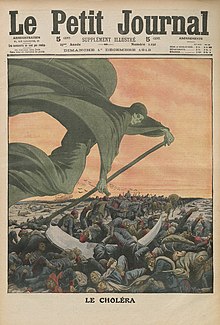1899–1923 cholera pandemic

The sixth cholera pandemic (1899–1923) was a major outbreak of cholera beginning in India, where it killed more than 800,000 people, and spreading to the Middle East, North Africa, Eastern Europe and Russia.[1]
History
According to Leonard Rogers, following an outbreak of cholera at the Haridwar Kumbh Mela, the epidemic spread to Europe via Punjab, Afghanistan, Persia, and southern Russia.[2][3]

The last cholera outbreak in the United States was in 1910–1911 when the steamship Moltke brought infected people to New York City from Naples. Vigilant health authorities isolated the infected on Swinburne Island, built in the nineteenth century as a quarantine facility. Eleven people died, including a health care worker at the island hospital.[4][5][6]
In 1913, the Romanian Army, while invading Bulgaria during the Second Balkan War, suffered a cholera outbreak that provoked 1,600 deaths.[7][8][9]
See also
References
- ^ "Cholera's seven pandemics". Canadian Broadcasting Corporation. December 2, 2008. Retrieved January 3, 2019.
At the turn of the century, the sixth pandemic killed more than 800,000 in India before moving into the Middle East, northern Africa, Russia and parts of Europe. By 1923, cholera had receded from most of the world, although many cases were still present in India.
- ^ R. Dasgupta. "Time Trends of Cholera in India : An Overview" (PDF). INFLIBNET. Retrieved December 13, 2015.
- ^ Rogers, L. (1926). The Conditions Influencing the Incidence and Spread of Cholera in India. Proceedings of the Royal Society of Medicine, 19(Sect Epidemiol State Med), 59–93.
- ^ The Boston Medical and Surgical Journal. Massachusetts Medical Society. 1911.
In New York, up to July 22, there were eleven deaths from cholera, one of the victims being an employee at the hospital on Swinburne Island, who had been discharged. The tenth was a lad, seventeen years of age, who had been a steerage passenger on the steamship, Moltke. The plan has been adopted of taking cultures from the intestinal tracts of all persons held under observation at Quarantine, and in this way it was discovered that five of the 500 passengers of the Moltke and Perugia, although in excellent health at the time, were harboring cholera microbes.
- ^ "Cholera Kills Boy. All Other Suspected Cases Now in Quarantine and Show No Alarming Symptoms" (PDF). New York Times. July 18, 1911. Retrieved July 28, 2008.
The sixth death from cholera since the arrival in this port from Naples of the steamship Moltke, thirteen days ago, occurred yesterday at Swinburne Island. The victim was Francesco Farando, 14 years old.
- ^ "More Cholera in Port". Washington Post. October 10, 1910. Retrieved December 11, 2008.
A case of cholera developed today in the steerage of the Hamburg-American liner Moltke, which has been detained at quarantine as a possible cholera carrier since Monday last. Dr. A.H. Doty, health officer of the port, reported the case tonight with the additional information that another cholera patient from the Moltke is under treatment at Swinburne Island.
- ^ Leașu, Florin; Nemeț, Codruța; Borzan, Cristina; Rogozea, Liliana (2015). "A novel method to combat the cholera epidemic among the Romanian Army during the Balkan War - 1913". Acta Medico-Historica Adriatica. 13 (1): 159–170. PMID 26203545.
- ^ Ciupală, Alin (May 25, 2020). "Epidemiile în istorie | O epidemie uitată. Holera, România și al Doilea Război Balcanic din 1913" (in Romanian). University of Bucharest.
- ^ Stoica, Vasile Leontin (2012). Serviciul Sanitar al Armatei Române în perioada 1914-1919 (PDF) (Thesis) (in Romanian). Chișinău: Ion Creangă State Pedagogical University. pp. 1–196.
Further reading
- Hays, J.N. (2005). Epidemics and Pandemics: Their Impacts on Human History. ABC-CLIO. ISBN 9781851096589.
- Azizi, Mohammad-Hossein; Azizi, Farzaneh (January 2010). "History of Cholera Outbreaks in Iran during the 19th and 20th Centuries". Middle East Journal of Digestive Diseases. 2 (1): 51–55. ISSN 2008-5230. PMC 4154910. PMID 25197514.
- 19th-century health disasters
- 19th-century epidemics
- 19th century in India
- 20th-century health disasters
- 20th-century epidemics
- 20th century in India
- Cholera pandemics
- Epidemics in India
- 1899 disease outbreaks
- 1900s disease outbreaks
- 1910s disease outbreaks
- 1920s disease outbreaks
- 19th century in Nepal
- 20th century in Nepal
